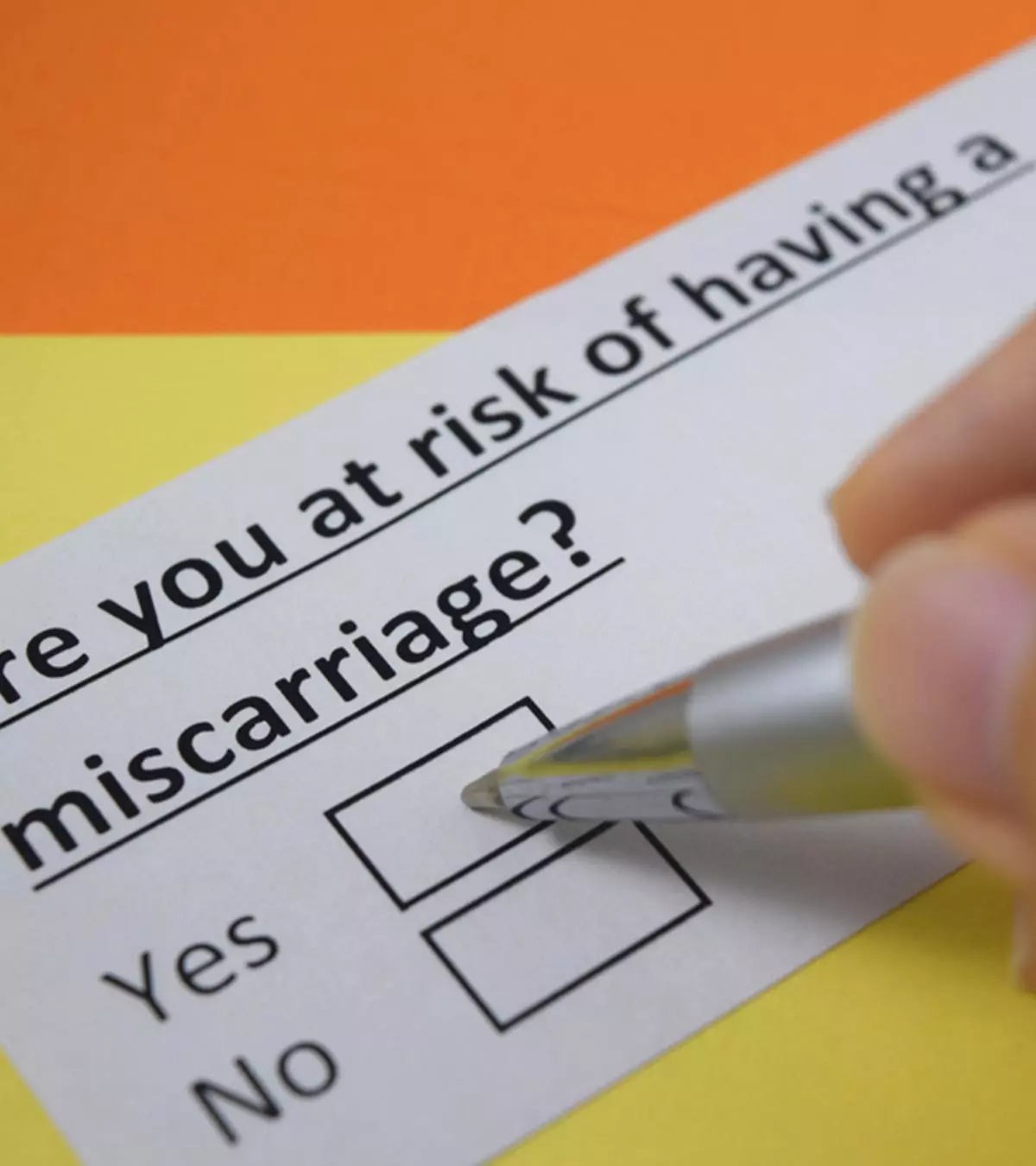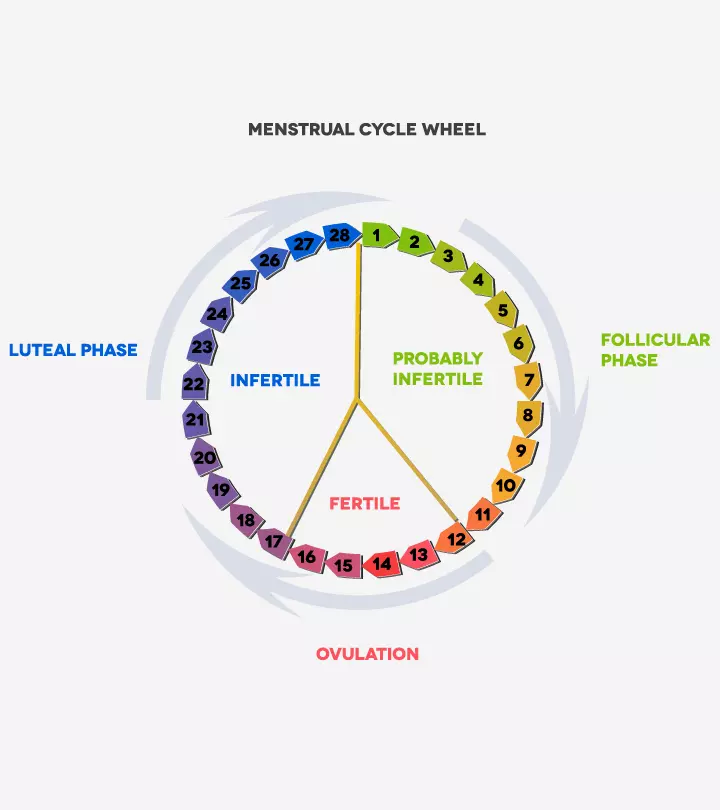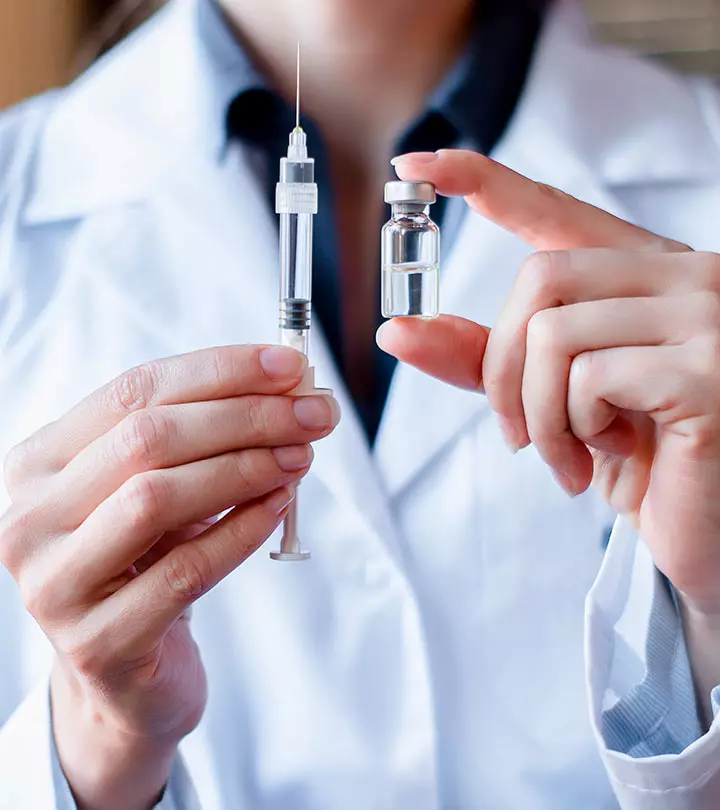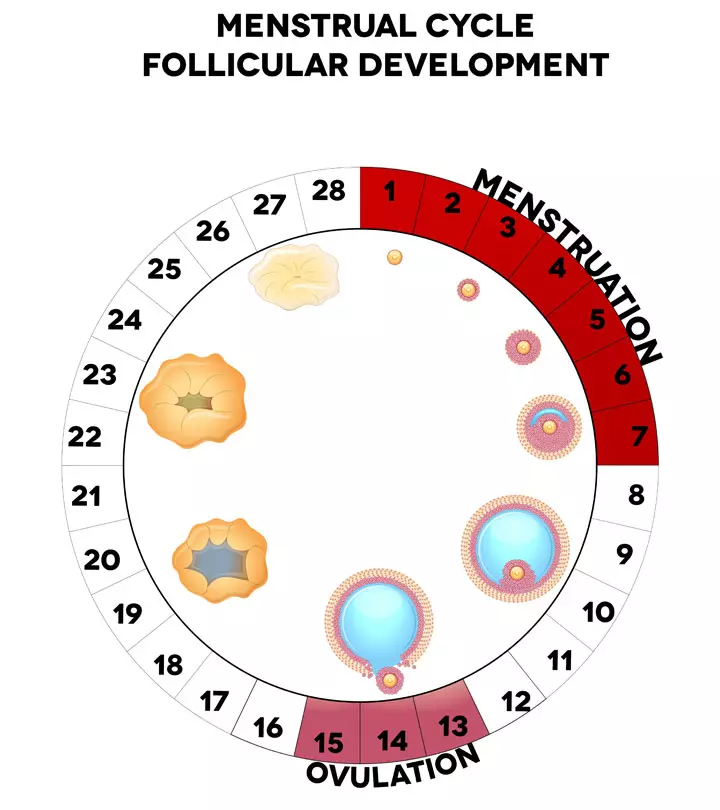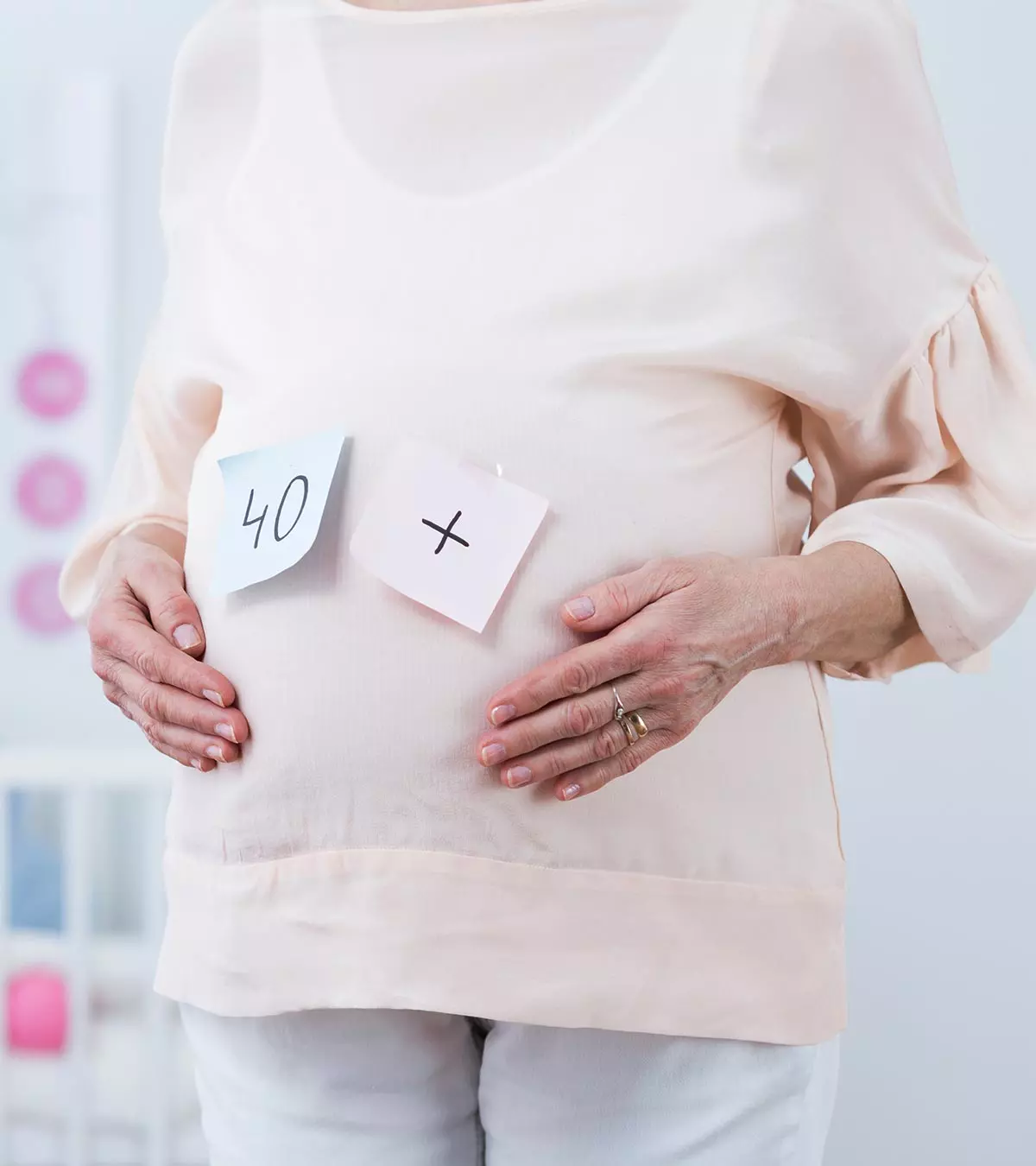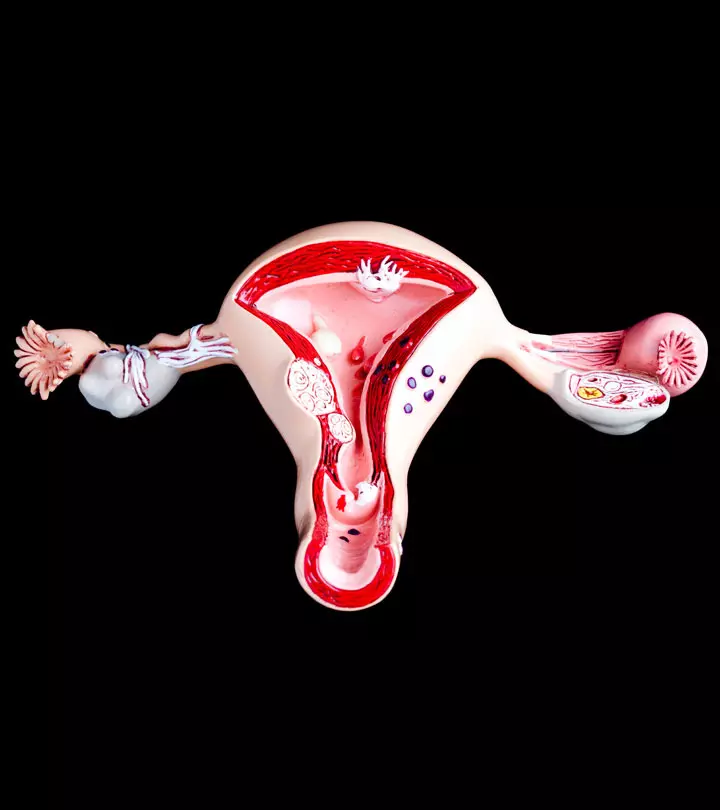
Image: iStock
The endometriumiTissues that line the uterus or the womb is the tissue that normally lines the uterus or womb. Endometriosis is a disorder when the tissue similar to the endometrium grows outside the uterus and on the other areas of the body. The following post discusses endometriosisiThe condition identified by an abnormal growth of intrauterine tissues outside the uterus and causes irregular and painful periods and pregnancy and how the condition impacts fertility, pregnancy, and the baby.
Endometriosis is most commonly found on the ovaries, fallopian tubes, outer surface of the uterus, and on the tissues that hold the uterus in its place. It may also appear on the vagina, vulvaiThe outer part or the external genitalia of females , bowel, bladder, or rectum. It rarely appears on other body parts such as skin, lungs, or brain. According to the World Health Organisation (WHO), about 10% of women are affected by endometriosis, on a global level. In addition, it is also believed to affect more than 11% of women between the ages 15 and 44 (1).
Key Pointers
- Abnormal tissue growth on ovaries and fallopian tubes characterizes endometriosis, which affects women aged 15-44.
- Excessive estrogen levels, retrograde menstruation, bodily fluids, and immune system disorders can trigger endometriosis.
- Symptoms include reduced fertility, difficulty conceiving, painful and heavy periods, pelvic pain, premenstrual symptoms, and discomfort during sex.
- Women with mild endometriosis generally have healthy, successful pregnancies.
- Treatment for endometriosis can involve pain relievers, laparoscopy, laparotomy, hysterectomy, bowel surgery, and hormonal medications.
Causes Of Endometriosis
The exact cause of endometriosis is unknown. However, some possible factors that may cause endometriosis in women are (1) (2):
- Retrograde menstruation: It is characterized by some endometrial tissue flowing up through the fallopian tubes and embedding on to the organs in the pelvis instead of leaving the body as a menstrual flow.
- Problems with the immune system: A weak immune system may not identify and destroy endometrial tissue that grows outside the uterus. As a result, women with endometriosis may present with certain cancers and immune system disorders.
- Hormones: High estrogeni A sex hormone responsible for the development of female sexual characteristics levels can promote endometriosis. However, more research is needed to establish the role of a woman’s hormone system in causing endometriosis.
- Surgery: Endometrial tissue may be picked up and can be moved to other areas accidentally during an abdominal surgery such as a hysterectomy or cesarean section (C-section), leading to endometriosis.
- Bodily fluids: Endometrial cells may also spread to the woman’s body through blood or lymph.
Risk Factors For Endometriosis

Image: Shutterstock
The following are the suspected risk factors for endometriosis (1) (3):
- Family history
- Early menarche
- Heavy or painful periods
- Short menstrual cycles (less than 27 days)
- Long periods (longer than one week)
- Allergies, such as food allergies, eczemaiA skin condition characterized by dry, itchy, and inflamed skin , or hay fever
- Obesity
- Exposure to toxins
Symptoms Of Endometriosis

Image: Shutterstock
The symptoms of endometriosis can vary from one woman to another. While some women may have hardly noticeable symptoms, other women might experience severe pain that can hamper going to school or work. The symptoms of endometriosis may include (2) (3).
- Painful cramps during periods
- Pelvic pain (pain in the lower tummy or back) that usually worsens during periods
- Pain during or after sex
- Ovulation pain
- Pain in the lower back or thighs
- Pain while using bowel (bowel symptoms)
- Pain while peeing (bladder symptoms)
- Reduced fertility
- Nausea
- Lethargy
- Premenstrual symptoms
- Feeling sick or experiencing constipation, diarrhea, or bloody urine during periods.
- Heavy menstrual flow
- Problems with conception
Endometriosis may also lead to feelings of depression in women.
 Did you know?
Did you know?Stages Of Endometriosis
According to the American Society of Reproductive Medicine, endometriosis is classified into the following stages based on the location, amount, depth, and size of endometrial tissue (4) (5).
| Stage 1 (1-5 points) |
|
| Stage 2 (6-15 points) |
|
| Stage 3 (16-40 points) |
|
| Stage 4 (>40 points) |
|
The spread of the endometrial tissue, involvement of the pelvic structures by the disease, extent of pelvic adhesioniBands that form in the uterine cavity in response to a uterine procedure , and the blockage of the fallopian tubesi Muscular, hollow ducts connecting the uterus with the ovaries to transport eggs during ovulation are specific criteria that help in grading the stages of endometriosis.
The stage of endometriosis does not necessarily mean the level of pain, other symptoms, or the probability of infertility a woman would experience. For instance, a woman in stage one can have tremendous pain, while stage four can be completely asymptomatic (4).
Impact Of Endometriosis On Fertility

Image: Shutterstock
Although endometriosis impacts a woman’s chance of getting pregnant, most women with mild endometriosis are not infertile. Around 70% of women with mild to moderate endometriosis get pregnant without any medical intervention.
While the exact link between infertility and endometriosis is unknown, the severity of the condition and the location of the endometrial tissue also plays a role in determining the outcome. It is important to know that even with severe endometriosis, natural conception is possible (6).
Impact Of Endometriosis On Pregnancy And Baby
Most women with endometriosis have a normal pregnancy, and no extra monitoring or special care is needed. However, the doctor will monitor your blood pressure.
Women with endometriosis may be at a slightly higher risk of developing the following complications (6) (7).
- Bleeding towards the end of pregnancy.
- Placenta previa (low-lying placenta)
- Ectopic pregnancyi A life-threatening form of pregnancy where the egg fertilizes on the fallopian tubes rather than the uterus leading to blood loss
- Low birth weight
- Preterm delivery
Endometriosis may improve during pregnancy, due to no periods, but it might recur and cause problems with conceiving again (7).
 Things to know
Things to knowDiagnosis Of Endometriosis
The doctor will ask for a detailed medical history to exclude other possible causes for the symptoms. Typical symptoms of endometriosis and pain that do not improve with usual medicines for menstrual pain may indicate the presence of endometriosis.
The following tests may help confirm the diagnosis (3) (4).
- Laparoscopy is a surgical procedure done under general anesthesia to examine the pelvic organs. The collected sample is sent for biopsy to determine the location, extent, and size of endometrial growths.
- An ultrasound scan uses sound waves to create a video image of the pelvic organs by pressing a transducer against the abdomen externally or inserting the probe into the vagina.
- Colonoscopy is done under sedation, wherein a medical probe with a camera is attached to examine the bowel. It will check if endometriosis is affecting the bowel.
- Blood tests may be useful in later stages of endometriosis.
- CT scan uses a combination of x-rays and computer technology to produce images of any abnormalities present in the body. A CT scan may help get images that X-rays cannot.
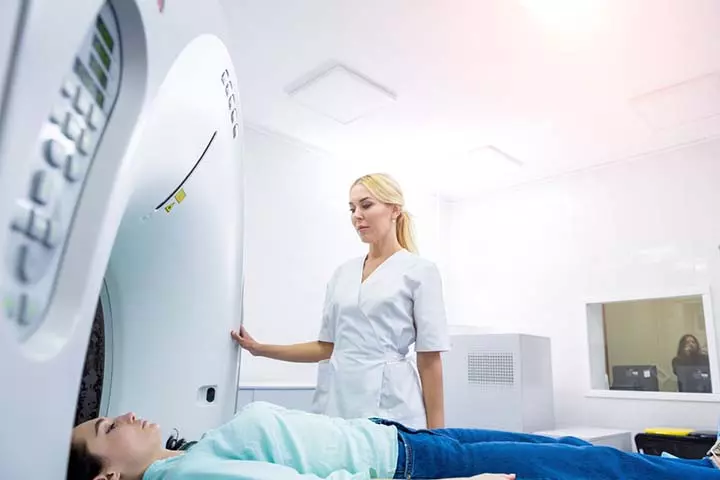
Image: Shutterstock
- The combination of x-rays and computer technology to produce images are used to know about any abnormalities present in the body. A CT scan may help to get images that X-rays cannot.
- MRI scan is a non-invasive procedure that produces a two-dimensional view of any internal organs or structures.
It is impossible to diagnose endometriosis during the internal examination, and the doctor may refer you to a gynecologist.
Treatment For Endometriosis
The treatment for endometriosis depends on the extent of the disease, symptoms, past medical history, overall health, tolerance for certain medicines and procedures, and your desire to have children. Endometriosis may be treated with medicines, surgery, or both (8).
Medicines for endometriosis (4)
1. Pain killers
Nonsteroidal anti-inflammatory drugs (NSAIDs), such as ibuprofen or other OTC drugs are used for pain relief.
2. Hormonal medications
- Oral contraceptives, with estrogen and progesteroneiA female hormone responsible for menstruation and pregnancy help prevent ovulation and reduce menstrual flow.
- Progestini A synthetic form of the hormone progesterone -only medications
- Gonadotropin-releasing hormone (GnRH) agonists stop ovarian hormone production and thereby create a sort of “medical menopause”
- Danazol, a synthetic derivative of the male sex hormone testosterone
Surgical correction for endometriosis (4)
3. Laparoscopy
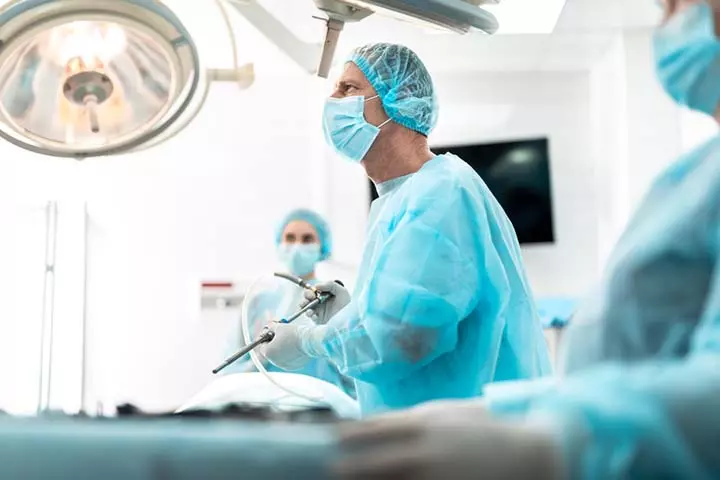
Image: Shutterstock
A thin tube with a lens and a light is inserted into the abdominal cavity by making a small incision in the abdominal wall. The doctor will then remove the endometrial growths.
4. Laparotomy
The more extensive surgery removes the maximum possible endometrium, with minimum damage to the healthy tissue.
5. Hysterectomy
It is a procedure to remove the uterus and possibly along with the ovaries or fallopian tubes (9). It is recommended when all other treatments do not work. Heavy periods, fibroids, pelvic pain, prolapse of the uterus, ovarian cancer, cervical cancer, uterine cancer, etc., are some reasons that may indicate the need for hysterectomy (10).
6. Bowel surgery
This may be recommended if endometriosis has developed in the bowel wall. (3)
After numerous unsuccessful attempts to conceive, doctors diagnosed Marcy Hanson with PCOS and didn’t consider endometriosis. None of the treatments or medications she tried improved her chances of getting pregnant. After years of unsuccessful treatment, she eventually found a doctor who agreed to perform a hysterectomy. Following the surgery, the doctor informed her that both of her ovaries were severely affected by cysts, and she had extensive endometriosis. Marcy expressed, “So now I knew. I had suspected endometriosis, but no one had confirmed it. I was convinced that PCOS couldn’t be the sole reason for my infertility, and it turns out I was right.”
Hanson’s case emphasizes why timely diagnosis and treatment are necessary. She adds, “So, while I didn’t know for sure if it was a cause of my troubles, endometriosis was always the silent culprit in my pain and infertility. Had I found out sooner, I may have been able to do things differently (i).”
Pregnancy Chances After Endometriosis Surgery
If you have had surgery, you can either try to get pregnant naturally or get help from medical methods. Your surgeon will assess the chances of getting pregnant with the help of the Endometriosis Fertility Index (EFI). It considers the factors, including previous pregnancy, the length of your infertility, age, and the severity of endometriosis and how it has affected your fallopian tubes (6).
Prevention Of Endometriosis
While prevention of endometriosis is not entirely possible, you can reduce your chances of developing endometriosis by lowering the estrogen hormone levels in your body.
The following measures could help (1).
- Ask your doctor if you can use hormonal birth control methods such as pills, rings, or patches with low estrogen doses.
- Exercising regularly for at least four hours a week can help you lower your body fat percentage levels. A low-fat diet and regular exercise help decrease the amount of estrogen in the circulating blood.
- Avoid consuming alcohol in large amounts as it can raise estrogen levels. You should not consume more than one drink per day if you choose to consume alcohol.
- Avoid more than one drink of caffeine-rich liquids such as tea, coffee, and sodas to raise estrogen levels.
 Point to consider
Point to considerComplementary And Alternative Medicine For Endometriosis
Some women may find natural therapies helpful in treating endometriosis. However, as there is no medical evidence to support these claims, you should contact your healthcare provider before considering or using any of these therapies.
The following therapies can help treat some endometriosis symptoms (3).
- Herbal medicines: Herbs such as Chinese herbs, homeopathy, ayurvedic medicines, and naturopathy may offer relief from endometriosis pain (11).
- Traditional Chinese massage: Tui Na, the traditional Chinese massage, focuses on grasping and pulling certain muscles and offers relief from pain (12).
- Nutritional therapies: Diet plans low in fat and high in fiber aid in reducing estrogen (13).
- Yoga practice: Yoga helps in reducing chronic pelvic pain that arises from endometriosis. Yoga helps women with endometriosis achieve a better quality of life (14).
Frequently Asked Questions
1. Does surgery or having a laparoscopy increase my chances of getting pregnant?
If endometriosis is causing problems with conceiving, surgical removal of the tissue can improve your chances of pregnancy (6).
2. Does pregnancy cure endometriosis?
No, pregnancy may temporarily suppress the symptoms of endometriosis but does not cure it at its root. The symptoms usually reappear after childbirth or cessation of breastfeeding (15).
3. Does endometriosis increase the risk of having a miscarriage?
Miscarriage occurs in around one in five pregnancies. However, the risk increases to one in four pregnancies (16).
4. Does endometriosis increase the risk of ectopic pregnancy?
While around one in 80 to 100 pregnancies end up as ectopic pregnancy, the risk is more than doubled in women with endometriosis (16).
5. How can I prevent miscarriage with endometriosis?
Endometriosis may increase the risk of miscarriage. You can only prevent miscarriage with endometriosis treatment. In most cases, surgery is recommended. However, you may consult your doctor to know what procedure suits you the best (17).
6. Does endometriosis affect egg quality?
Studies show that endometriosis can adversely affect the oocyteiAn immature egg cell that develops into an egg quality, hampering its ability to complete maturation and undergo fertilization (18).
7. Can endometriosis destroy an ovary?
Deep ovarian endometriosis may destroy ovarian tissue, leading to premature ovarian failure. This may cause problems with ovulation and ovarian functions (19).
8. Is IVF possible with endometriosis?
Some women with endometriosis may have successful pregnancies with IVF. However, if you experience repeated IVF failures, it may affect you physically, emotionally, and financially. In such cases, doctors may recommend getting your endometriosis treated for successful results (20).
Endometriosis can have a great impact on a woman’s mental well-being. Those who experience severe pain might know that endometriosis can be a life-changing and debilitating condition, especially for women trying to conceive. If you feel anxious or depressed due to endometriosis, you may seek help from a healthcare provider.
Infographic: What Are The Treatments Available For Endometriosis?
Endometriosis may be managed with medications, surgical procedures, or a combination of both. The course of the treatment depends on the severity of the condition. The infographic below summarizes the available treatments for endometriosis.

Illustration: Momjunction Design Team
Illustration: How To Get Pregnant With Endometriosis? Chances And Best Age

Image: Dalle E/MomJunction Design Team
Discover effective tips and strategies to increase your chances of conceiving quickly while managing endometriosis. Learn valuable insights and expert advice in this informative video guide.
Personal Experience: Source
MomJunction articles include first-hand experiences to provide you with better insights through real-life narratives. Here are the sources of personal accounts referenced in this article.
i. My story: Marcy Hanson.https://www.emlwy.com/2013/01/my-story-marcy-hanson.html?m=1
References
- Endometriosis.
https://womenshealth.gov/a-z-topics/endometriosis - Endometriosis.
https://www.nhs.uk/conditions/endometriosis/ - Endometriosis.
https://www.betterhealth.vic.gov.au/health/conditionsandtreatments/endometriosis - Endometriosis.
https://www.hopkinsmedicine.org/health/conditions-and-diseases/endometriosis - Endometriosis Stages: Understanding the Different Stages of Endometriosis
https://www.endofound.org/stages-of-endometriosis - How does endometriosis affect fertility?
https://www.tommys.org/pregnancy-information/planning-a-pregnancy/fertility-and-causes-of-infertility/how-does-endometriosis-affect-fertility - How endometriosis affects pregnancy.
https://www.pregnancybirthbaby.org.au/how-endometriosis-affects-pregnancy - Endometriosis.
https://www.acog.org/womens-health/faqs/endometriosis - Endometriosis.
https://medlineplus.gov/endometriosis.html - Why it’s necessary: Hysterectomy.
https://www.nhs.uk/conditions/hysterectomy/why-its-done/ - Complementary and Alternative Therapies for Endometriosis.
https://www.brighamandwomens.org/obgyn/infertility-reproductive-surgery/endometriosis/complimentary-and-alternative-therapies-for-endometriosis - ENDOMETRIOSIS DIMINISHED WITH TRADITIONAL CHINESE MEDICINE.
https://www.pacificcollege.edu/news/blog/2014/09/15/endometriosis-diminished-with-traditional-chinese-medicine - Endometriosis.
https://nutritionguide.pcrm.org/nutritionguide/view/Nutrition_Guide_for_Clinicians/1342065/all/Endometriosis - Move to improve. The benefit of exercise for endometriosis.
https://endometriosisaustralia.org/blog/ - Myths and misconceptions in endometriosis.
https://endometriosis.org/resources/articles/myths/ - ENDOMETRIOSIS FERTILITY AND PREGNANCY.
https://www.endometriosis-uk.org/endometriosis-fertility-and-pregnancy - Endometriosis and miscarriage – an overview of current evidence.
https://www.tommys.org/about-us/charity-news/endometriosis-and-miscarriage-overview-current-evidence - Ana Maria Sanchez et al.; (2017); Is the oocyte quality affected by endometriosis? A review of the literature.
https://www.ncbi.nlm.nih.gov/pmc/articles/PMC5508680/ - Deep Ovarian Endometriosis (Endometriomas).
https://www.brighamandwomens.org/obgyn/infertility-reproductive-surgery/endometriosis/deep-ovarian-endometriosis#:~:text=These%20lesions%20respond%20very%20poorlyovulation%20or%20decreased%20ovarian%20function. - Chenyi Zhong et al.; (2021); Analysis of IVF/ICSI Outcomes in Endometriosis Patients With Recurrent Implantation Failure: Influence on Cumulative Live Birth Rate.
https://www.ncbi.nlm.nih.gov/pmc/articles/PMC8362597/ - What are the risk factors for endometriosis?
https://www.nichd.nih.gov/health/topics/endometri/conditioninfo/at-risk
Community Experiences
Join the conversation and become a part of our nurturing community! Share your stories, experiences, and insights to connect with fellow parents.
Read full bio of Dr. Anita Gupta
Read full bio of Dr. Ritika Shah
Read full bio of Rebecca Malachi
Read full bio of Dr. Joyani Das










